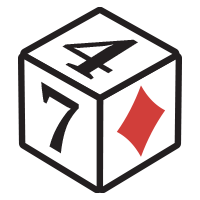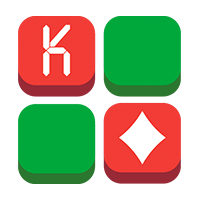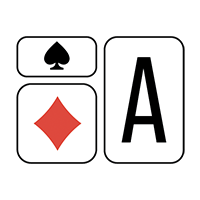Qing Yang is currently making content for GTO Wizard, and has abandoned his old YouTube channel, Poker Giraffe. But over the past few years, he has created a lot of good content for it, and we decided that it would be a shame to waste it.
Punish Aggro 3-Bettors with This Simple Trick
If you pull up GTO Wizard and look at BTN’s response versus a SB 3-bet, it actually recommends 4-bet jamming with QJs. So, what’s the idea behind this crazy-looking play, and is it worth doing in practice?
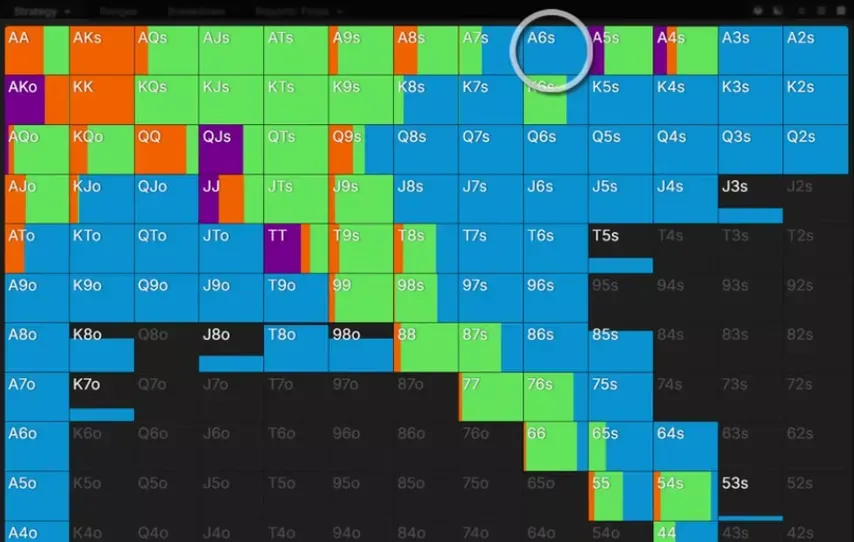
The logic starts with QJs’ ability to fold out dominating hands like AQ and KJ, which might call a smaller 4-bet. By jamming, you deny these hands their 70% equity share...
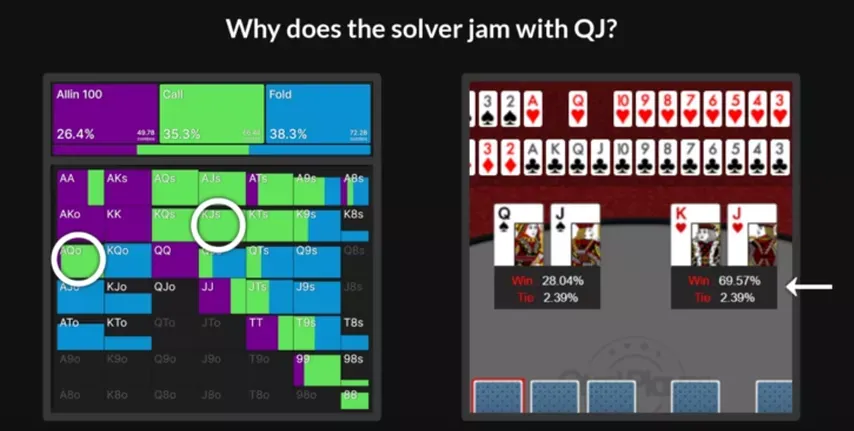
...and avoid scenarios where you flop a pair (Q or J) only to lose to top pair with a higher kicker.

If you instead jam a hand like AJ, many of the hands that fold are now big underdogs against us, so there is more value in calling and keeping them in SB’s range. The times that we flop a J, we actually want our opponent to have KJ and QJ. So even though AJ is a much stronger hand than QJ, the solver doesn’t consider jamming with it.
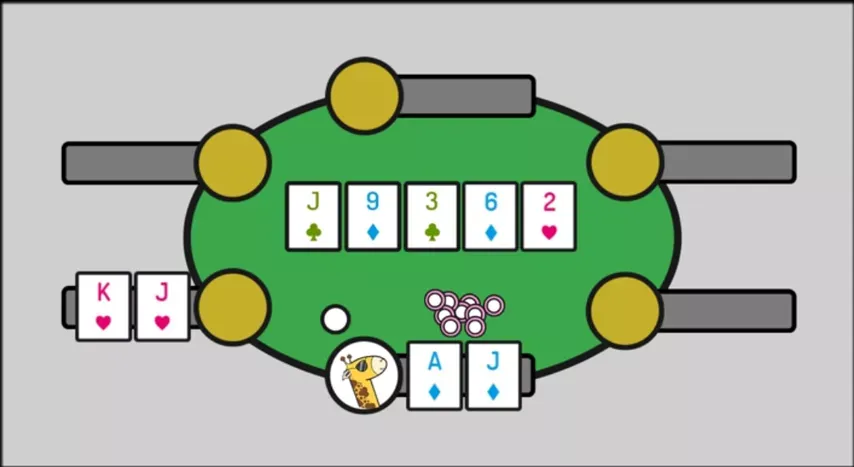
Of course, if folding out better hands was the only reason to jam, we would also be going all in with QJo and a ton of other trashy hands as well.
This brings us to the second reason: equity when called.
The thing about QJs is that we are never in really bad shape when called. Well, unless we are unlucky enough to run into a big pair—but even then, our hand’s straight and flush possibilities still give us about 20% equity. Against the rest of the calling range, we are in much better shape: 38% equity against JJ, and essentially flipping against TT and below. In particular, QJs does really well against AK, with up to 40% equity depending on suits.
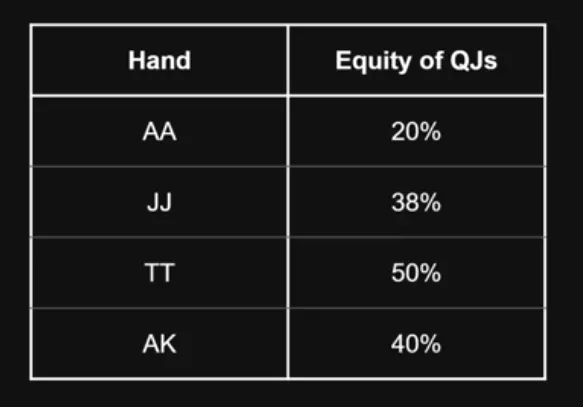
This last point is really important because AK is such a big part of SB’s calling range. You can’t really tell from the hand grid, since each box contains a different number of combos. But if we look at this normalized pie chart, we see that AK actually makes up 27% of the calling range, and that this number further increases when we take our hand’s blockers into account.

So, as crazy as it sounds, QJs is actually one of the best no-pair hands to be jamming as a bluff.
There is a small problem, however.
The solution to this problem lies in how we play our AK. SB is unable to call off with AQ because we are also jamming with AK at some frequency. To be absolutely clear, I’m not saying that we’re jamming AK for the sole purpose of folding out AQ and AJ. Instead, AK is jamming for its own set of reasons, the main one being equity denial. But a side effect of jamming is that it discourages SB from calling off with worse A-highs.

This is a key characteristic of GTO strategies: every hand has its best interest in mind, but different hands are also working in harmony to maximize the EV of our range. When we jam QJ and AK as a pair, we don't actually care what SB does with AQ or AJ. If they fold, then it justifies our jam with QJ. If they call, then QJ goes down in EV, but all of this EV is recouped in the form of extra value for AK.
It’s just like when we bet the river with a balanced range of value and bluffs: no matter how our opponent reacts, our range is always guaranteed a minimum amount of EV, because any EV lost by one type of hand is simply transferred to the other.
Okay, so we jam with QJs, mix in a bunch of AK, and there is nothing that SB can do to exploit us.
Or is there?
Well, if our jamming range consists of only QJ and AK, then SB should just call the jam with any pocket pair. This creates a bit of a problem, since a big part of why we jam with AK in the first place is to force hands like 66 and 77 off their 50% equity share. This brings us to the final piece of the puzzle: JJ and TT.
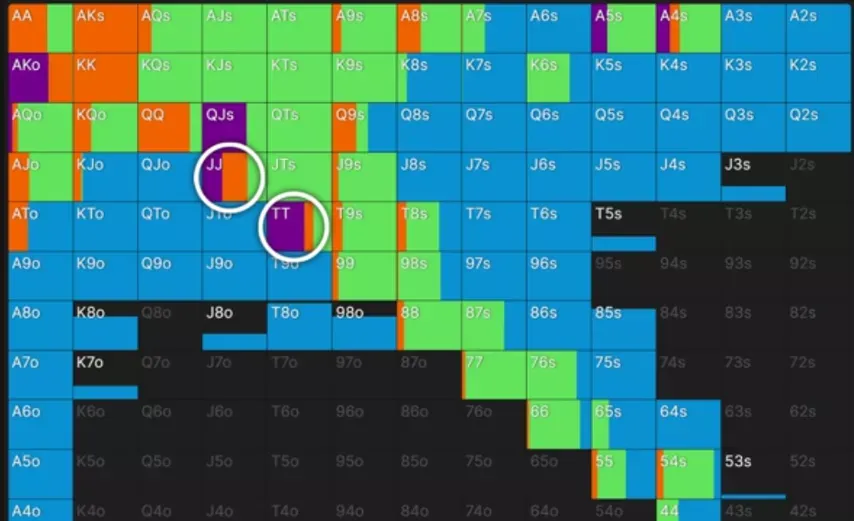
By jamming these hands together with AK, we put SB’s pocket pairs in a difficult spot. Call it off, and our JJ/TT generate a ton of value. Fold, and our AK denies a ton of equity. At the same time, SB cannot simply call off with AQ/KQ because of the presence of AK in our jamming range. This allows our JJ/TT to deny some extra equity, which was really the main reason for jamming them in the first place.
In a way, these hands are like cogs in a machine. Remove any one of them, and the entire strategy falls apart. But together, they help to put a ton of pressure on our opponent, maximizing our EV and minimizing theirs.
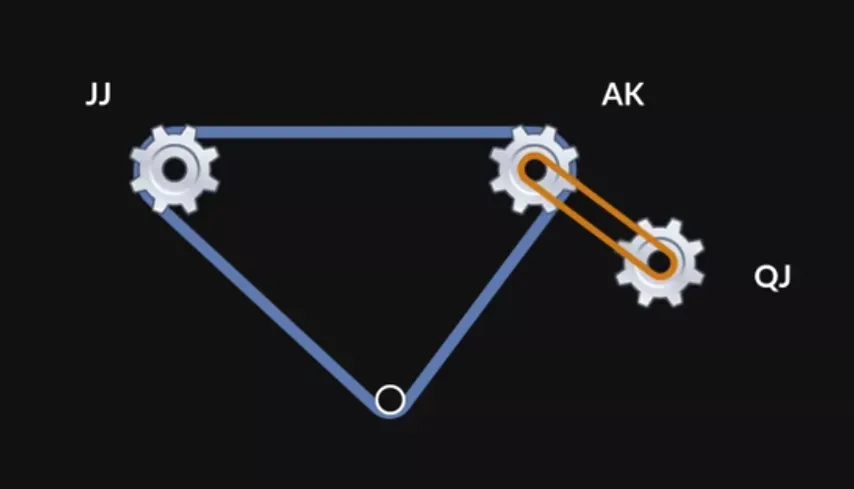
It should also be mentioned that QJ is not a critical component of this machine.
It’s just there to capitalize on folds from hands that dominate us, and our strategy still works whether or not we jam with QJ itself. For example, if we look at CO’s response versus a SB 3-bet, we see that QJs is now a pure call. SB is 3-betting a slightly tighter range, so QJ no longer denies enough equity to justify 4-bet jamming.
But apart from that, the rest of the strategy is quite similar. AK and JJ are still jamming at some frequency for the exact same reasons: to put pressure on lower pocket pairs and deny equity against AQ/KQ.
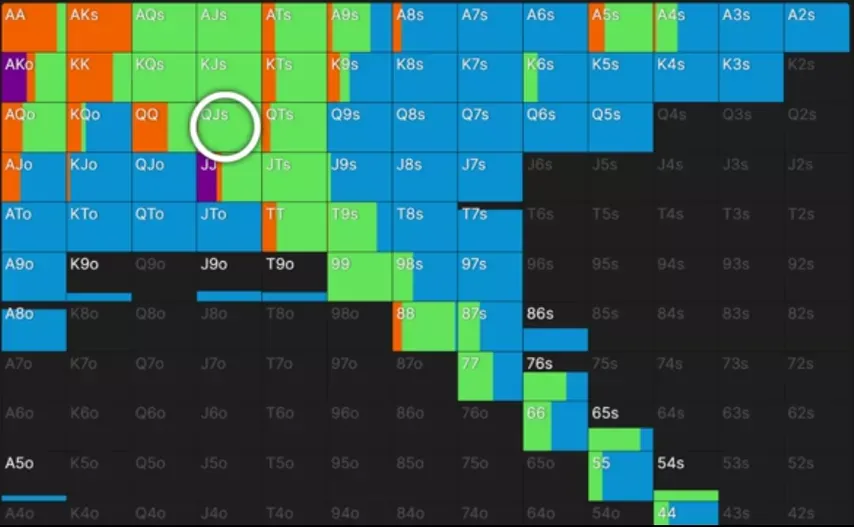
As we go earlier in the positions, our jamming range starts to change more significantly. Most notably, we now jam with KK instead of JJ.
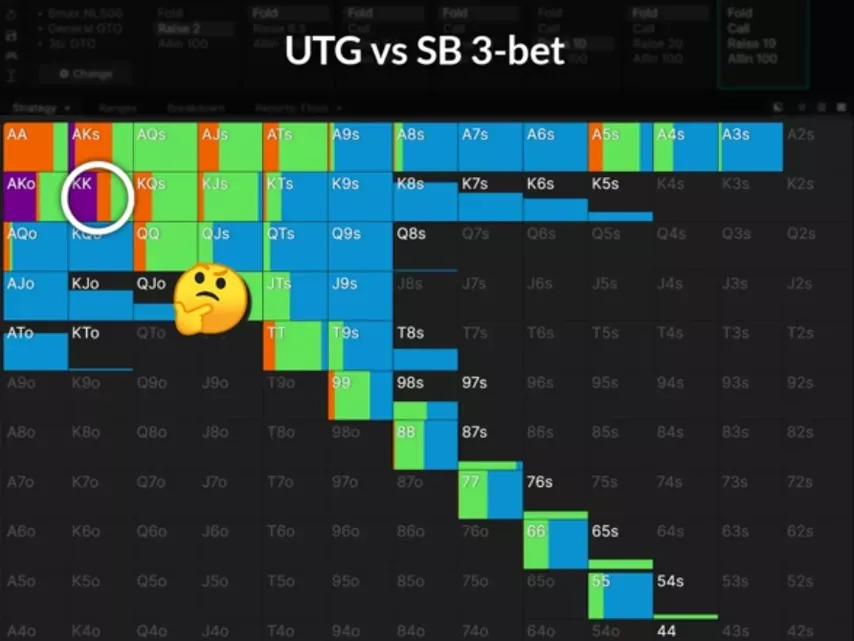
This looks a little strange at first: KK isn’t that vulnerable of a hand, so why rush to put all the money in? Well, SB is 3-betting lots of Ax, all of which have at least 30% equity against KK. So jamming does still deny a fair bit of equity. But more importantly, as SB’s range gets tighter, the hands that we target with the jam also change accordingly.
Versus late position, SB was 3-betting lots of middling pairs like 99/TT. By jamming a mix of JJ and AK, we force these pairs to either pay us off or forfeit their equity against AK. Against UTG, however, SB’s 3-betting range is more concentrated around bigger pairs like QQ/JJ.
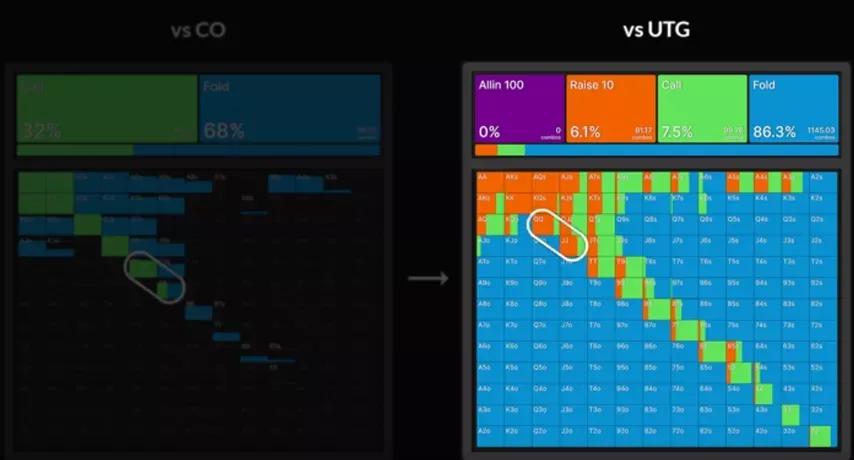
So if we want to make these hands indifferent, we need to be jamming with a bigger pair as well. The trick is to identify the worst pair that your opponent is 3-betting for value and then jam the pair that is a few ranks above it.
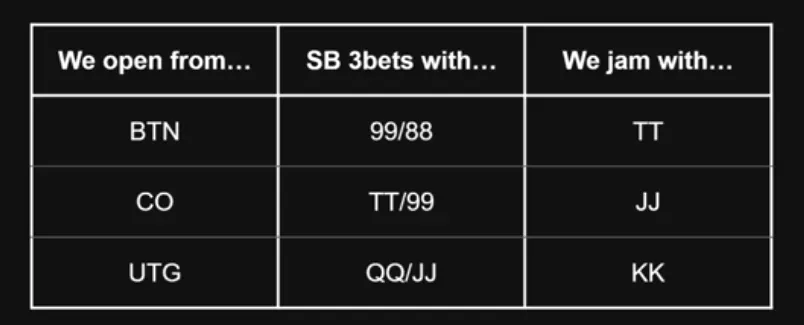
As for whether or not to do it in practice, let’s just say that there’s very little reason not to. The jamming range is easy to construct, and because we are going all in pre, there’s no chance of making postflop mistakes. It also works especially well against aggressive 3-bettors due to the increased amount of air in their range.
The more suited connectors and gappers someone is 3-betting, the more equity we deny when we jam our AK. And this can turn a slightly winning play into a hugely profitable one.
- Increased first deposit bonus
- Increased rakeback and reloads
- Help with deposits and cashouts
- Access to private freerolls
- Round-the-clock support
Why is K6 Solver's Favorite Hand?
Open up the solver and you’ll see that it loves defending with K6. It doesn’t matter if we’re facing an open, a 3-bet, or even a 4-bet—we consistently see the solver favor K6 over the stronger K7 and K8.
But what exactly is so special about the hand?
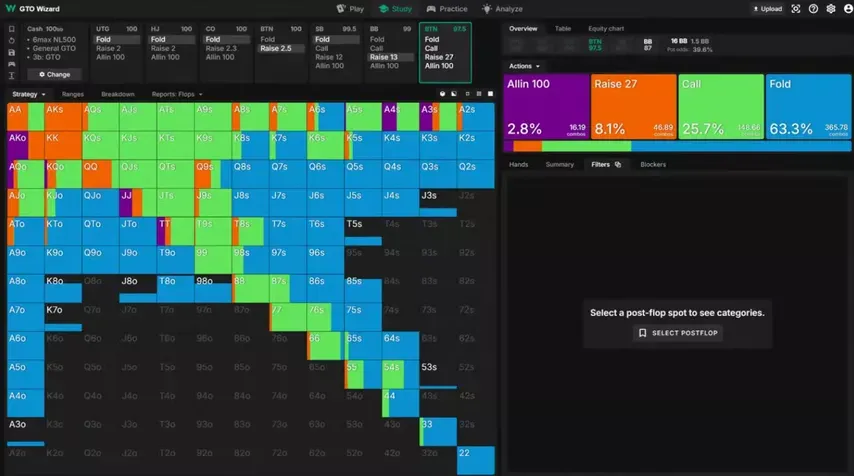
One possible explanation is that K6 has the ability to cooler Ax when the board comes 2-3-4-5.

The aggressor’s range is naturally weighted towards Ax, so there’s no lack of hands to pay us off when we hit the upper end of the straight.
For example, imagine if we call a 3-bet in position and the flop comes 2-3-4. Here, SB will typically play most of their Ax as a check-call. If the turn is a 5, SB starts to donk bet very aggressively, which makes sense given that two-thirds of their range has just improved to a straight.
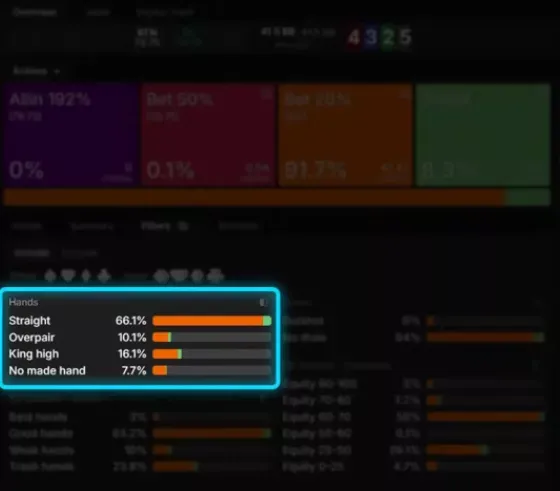
This gives a hand like K6 excellent implied odds: if we wanted to, we could just raise the turn and stack all of SB’s Ax on the spot.

The same can’t be said for a hand like K7. When the board comes 3-4-5-6, SB will play very passively instead, because it’s actually BTN who has the advantage in straights. This gives K7 worse implied odds and could explain why the solver doesn’t defend it preflop.
But if having a 6 is so good, why doesn’t the solver defend with every single 6x?
Let’s do a simple experiment where we add a bunch of 6x to BTN’s range.

Now, on the same board of 2-3-4-5, we see that SB is no longer donking as aggressively. In fact, they even start to check-fold some Ax, knowing that they are likely drawing dead to a 6.
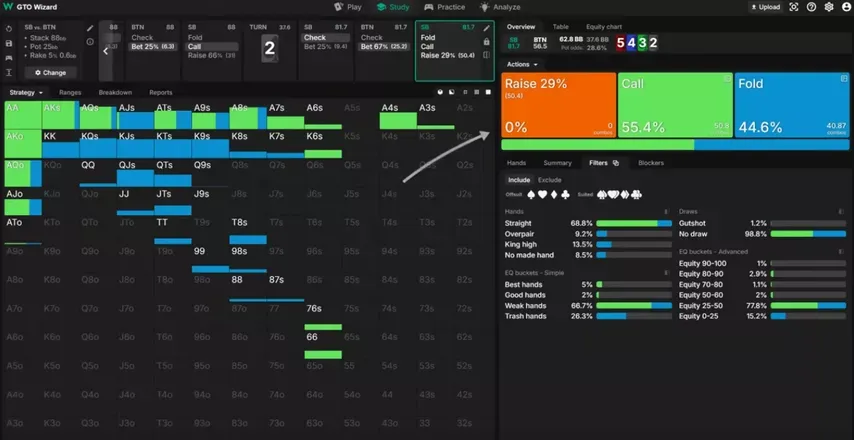
What this shows is that in order for 6x to have good implied odds, 6x cannot be overly represented in our range. Just like in real life where scarce items are deemed more valuable, scarce combos often generate more EV in poker as well.
So where does that leave us so far? We still want to call some 6x to cooler SB’s Ax, but we have to be a bit selective about the combos that we choose. Call too many, and our opponent might stop paying us off when we hit our straight.
Which 6x to choose?
In terms of which combos to call, 5-6 and 6-7 are both great candidates because of their extra connectivity. Combos with a high card are also good: K6, for example, makes a much better call than J6 because the times we hit our pair, it’s far more likely to be the best hand.
But if high card value is so important, why is the solver folding the highest 6x of all?

The most obvious answer is that A6 blocks some of the Ax that it wants to cooler. This reduces our implied odds when the board comes 2-3-4-5 and does affect the EV of our call somewhat. But there is a more important reason—one that has to do with the concept of scarcity.
If you look at the rest of our calling range, we have way more Ax compared to Kx.
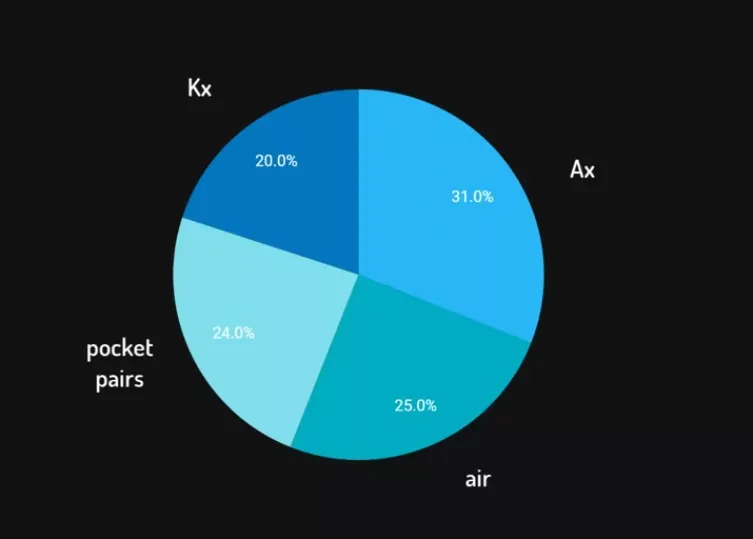
This reduces our implied odds the times we hit our ace. SB isn’t as likely to pay us off with hands like QQ or JJ because of the increased likelihood of us holding top pair. Compare this to how QQ and JJ will play on a K-high board. They’re much more willing to put in money and might even call us down if the runout is clean enough.
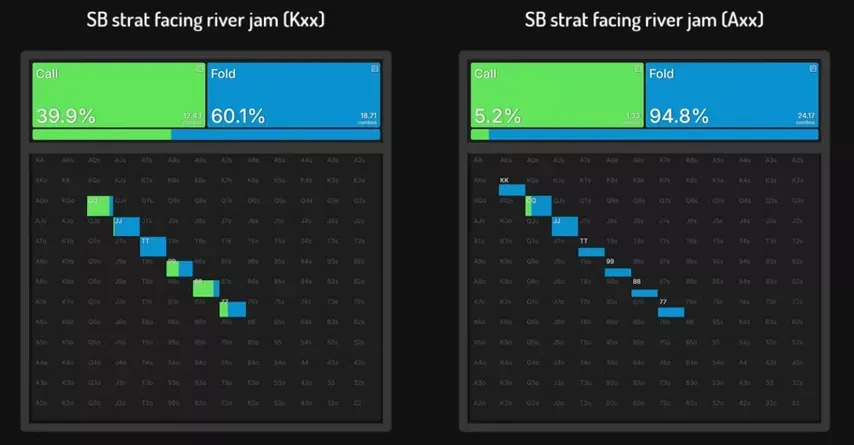
The end result is that Kx is actually worth more than Ax the times we hit our pair.
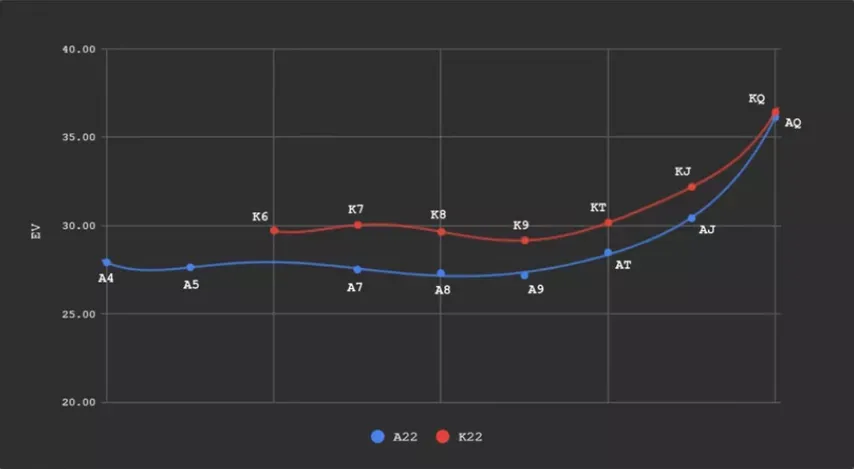
Even though our pair is not as strong, the scarcity of Kx in our own range makes it much easier to get value from worse. And this gives every single Kx, including K6, a big boost in EV.





